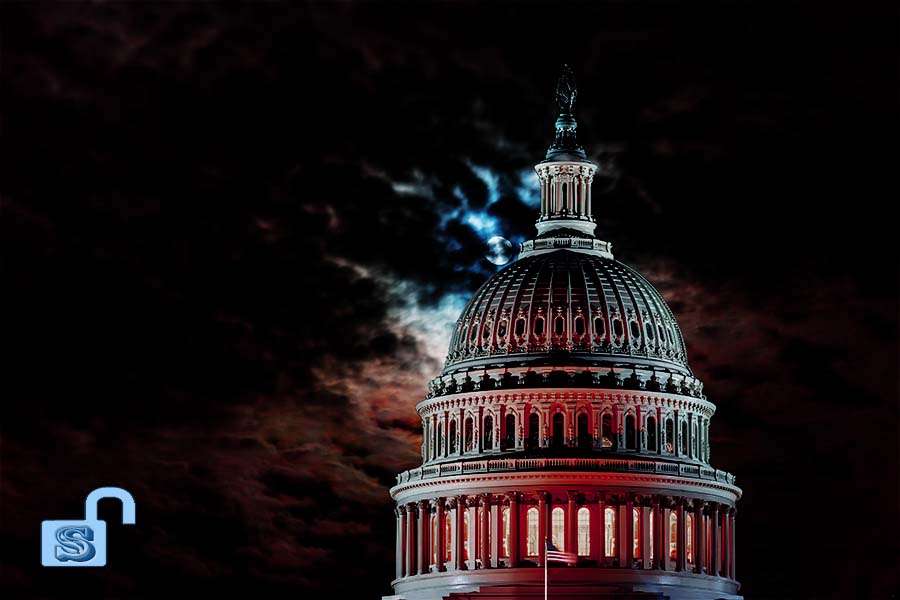◎ We strongly suspect that something most would consider unthinkable may have happened in Washington.
Updated on Jan. 8, 2021.
On Jan. 6, hundreds of thousands of Trump supporters gathered in Washington D.C. to protest alleged fraud in the 2020 U.S. presidential election. President Donald Trump spoke to crowds gathered outside the White House and in front of the Washington Monument before they marched to the U.S. Capitol building, where Congress was counting electoral votes, to continue the “Save America” rally.
As the protesters were making their way to the Capitol in the early and mid-afternoon, a small group of radicals gained entry into the building itself. Police claimed that the radicals used “chemical irritants” on Capitol police to force their way into the premises. The storming of the Capitol led to four deaths, according to news reports. Other law enforcement units, including from the Federal Bureau of Investigation, later arrived on scene to clear out the radicals. The FBI said they found and “rendered safe” two suspicious devices in Washington.
A curfew was imposed in D.C., and later extended to 15 days. National Guard units from D.C., Virginia, Maryland, and New York were dispatched to Washington; according to news reports, Army Secretary Ryan McCarthy and Acting Defense Secretary Christopher Miller mobilized the D.C. National Guard at Vice President Mike Pence’s approval.
The storming of the Capitol building led to the suspension of the ongoing Congressional session, but lawmakers returned late in the evening to certify electoral college votes for former vice president Joe Biden. Social media outlets removed some of President Trump’s posts and suspended his account (at the time of writing, 12 hours for Twitter, “indefinitely and for at least the next two weeks” on Facebook and Instagram).
Legacy media, pundits, and politicians have led calls to remove Trump via impeachment or the 25th Amendment. They also call for those who objected to the certification of electoral college votes or who persist in talking about election fraud to be punished. In the morning of Jan. 7, President Trump said in a statement, “Even though I totally disagree with the outcome of the election, and the facts bear me out, nevertheless there will be an orderly transition on January 20th.”
Legacy media, pundits, and politicians also framed the chaos at the Capitol as a Trump-incited “insurrection.” Efforts have been made to label all Trump supporters who showed up on Jan. 6 as a “mob,” even though only a tiny fraction of those present acted out of line.
The vast majority of Trump supporters who participated in the rally were peaceful, according to video footage and SinoInsider staff on site at the rally. However, our staff spotted a handful of agitators using megaphones to incite the crowd gathered outside the Capitol to storm the building; their calls were barely heeded by those present. That most of the protesters were not incited to violence but remained peaceful was not picked up by legacy media or pundits, who instead focused on the radical elements and blamed Trump.
Observers have noted a number of irregularities surrounding the Capitol building breach:
- Members of the anarcho-communist group Antifa appeared to have infiltrated the radicals who stormed the Capitol (see here, here, here, and here).
- Capitol police appeared to lift barriers and opened doors to “let” the radicals through.
- Guests on the Jan. 6 Tim Cast IRL who followed the Capitol drama on social media noted that people were “recording the empty streets” in the lead up to the outbreak of violence, as though “waiting for something to happen.”
Our staff who witnessed the scene unfolding and analyzed the news reports that followed were reminded of the storming of Hong Kong’s Legislative Council building in July 2019:
- The Hong Kong police mysteriously “withdrew” from the scene and “allowed” some of the radical protesters into the LegCo building.
- Hong Kong Police Commissioner Stephen Lo explained that the police withdrew after some protesters threw “toxic powder” at his officers while others attempted to interfere with the electrical system.
- The LegCo break in occurred after the annual July 1 protest, where 550,000 people marked the handover of Hong Kong to the People’s Republic of China. Also, those involved in the violence represented only a tiny fraction of the bulk of peaceful protesters in Hong Kong, but their actions were used to smear the entire anti-extradition bill protest movement.
- We wrote at the time: “Incitement is a favorite tactic of the Chinese Communist Party. With its involvement in student movements, revolutions, and violent class struggles, the Party has unparalleled experience in creating and using incitement to justify moving in to suppress “problematic” areas or groups. A common tactic is deploying agents to infiltrate groups, fracture the group and its cause, and provoke violence with the authorities to give the CCP a ready-made reason to launch a crackdown. The Tibetans, Uyghurs, protesters in Tiananmen Square, and retired military veteran protesters were all victims to CCP incitement tactics.”
Meanwhile, at least three other developments have deepened our suspicion as the events that transpired around the Capitol building:
- The U.S. stock market barely dipped when news of the Capitol breach broke, and continued to rally on Jan. 7. To draw a parallel, global markets also rose after the CCP passed the Hong Kong National Security law last year.
- On Jan. 6, over 50 Hong Kong politicians and pro-democracy advocates were arrested under the Hong Kong National Security Law.
- On Nov. 28, 2020, Di Dongsheng, vice dean of Renmin University’s School of International Relations, bragged during a forum that the CCP has “‘old friends’ in America’s core inner circle of power and influence” and has been “leveraging the core circle of power and influence in the United States” for decades. Di admitted that the CCP was unable to “fix” Trump, “but now Biden is elected. You can see that the traditional elite, the political elite, the establishment, they’re very close to Wall Street.”
Our take
SinoInsider condemns the radicals who participated in the storming of the U.S. Capitol building on Jan. 6. As we wrote in November 2020, “Americans need to stay true to traditional U.S. values and principles regardless of the election outcome. Half of America will almost certainly be disappointed with the certified election result when it is announced, but graceful concessions, not violence and protests, are in order.”
At the time of writing, information about the Capitol breach is still breaking. However, based on publicly available information and our insights into communist and Chinese Communist Party operations, we strongly suspect that something most would consider unthinkable may have happened in Washington, namely, a staged coup and successful communist “normalization” of the United States.
Based on incomplete information, we believe that one of two likely scenarios had unfolded.
In the first scenario, the radicals responsible for the chaos on the Capitol were not directed by any party, but resorted to extreme actions out of concern that Congress would not treat allegations of election fraud seriously as they counted the electoral votes. Anti-Trump/pro-China politicians, pundits, and the media later seized on the actions of a tiny few to tar the rest of Trump’s supporters, cut the president off completely from leveraging popular support, place Trump under control, and effectively neuter the White House. The CCP might not be directly involved in the events in D.C. in this scenario, but took advantage of a “failure of democracy” in America to advance its global domination agenda.
In the second scenario, the radicals were infiltrated and incited by leftist/communist elements in a planned “insurrection” as part of an effort to shut down all discussion about election fraud and oust President Trump. Anti-Trump/pro-China politicians, pundits, and the media then responded in the manner we laid out in the above paragraph. The CCP was either involved in the operation in some capacity (the “recycling” of the 2019 LegCo break-in playbook in D.C. is highly suspicious), or was made aware of it; either would explain the outrageous mass arrest of pro-democracy advocates in Hong Kong on the same day as the chaos on the Capitol. We are inclined to believe that this is the more likely of the two scenarios based on currently available information.
In the mid-1980s, KGB defector Yuri Bezmenov outlined the four stages of communist subversion—demoralization, destabilization, crisis, and normalization. He noted then that the Soviet Union had already succeeded in the demoralization of American society despite having anticipated that the process would take 15 to 30 years. Assuming the second scenario we laid out above is accurate, the CCP and pro-China forces in the U.S. appear to rush America through all four stages of communist subversion over the span of the presidential election process (on top of prior efforts to demoralize and destabilize Americans): Demoralization occurs with the media declaring Biden the winner and an intensification of hyperpartisan reporting; destabilization follows when a fraction of Trump supporters are radicalized after feeling they have recourse for justice after allegations of election fraud are dismissed on procedural grounds in the courts; crisis is what happened in the Capitol building in the afternoon of Jan. 6; and normalization is currently in progress.
What’s next
We hope to reverse our assessment of the present situation and stand corrected as more information becomes available. In the meantime, we again urge Americans to uphold traditional U.S. values and principles regardless of what the future may have in store. Violence and other extreme action will only invite a more rapid onset of authoritarian measures and further narrow the space in which Americans can operate to expose the truth and communism.
Communist China will definitely exploit chaos in America. The U.S. government needs to be vigilant about the CCP threat both in the U.S. and around the world, and be quick to respond.













